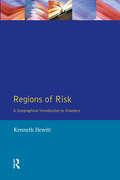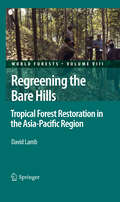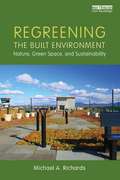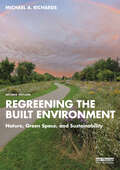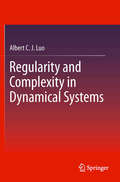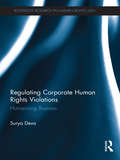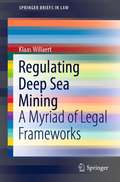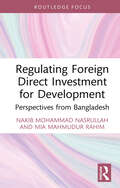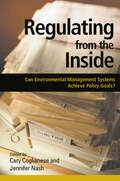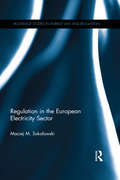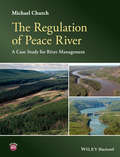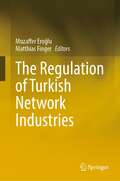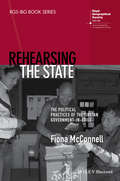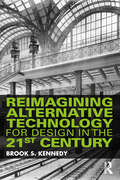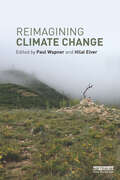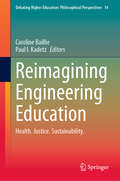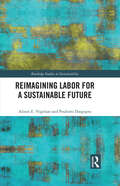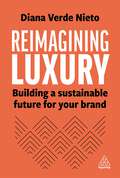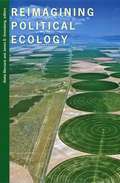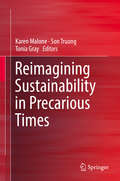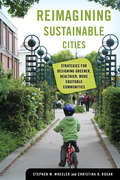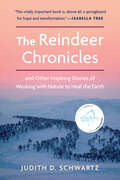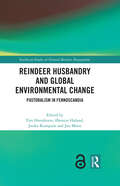- Table View
- List View
Regions of Risk: A Geographical Introduction to Disasters (Themes In Resource Management)
by Kenneth HewittAn introduction to hazards, human vulnerability and disaster, paying particular attention to the more severe or novel risks and disaster that affect the general public. The book is split into two parts, the first of which gives an overview of the field of risk and disaster in terms of three perspectives: hazards perspective; vulnerability perspective and the active perspective. The second part illustrates and develops these ideas in relation to some of the more severe dangers and disasters of the twentieth century, for example, earthquake risk, cities at risk and the civil disasters of war.
Regreening the Bare Hills
by David LambIn Regreening the Bare Hills: Tropical Forest Restoration in the Asia-Pacific Region, David Lamb explores how reforestation might be carried out both to conserve biological diversity and to improve the livelihoods of the rural poor. While both issues have attracted considerable attention in recent years, this book takes a significant step, by integrating ecological and silvicultural knowledge within the context of the social and economic issues that can determine the success or failure of tropical forest landscape restoration. Describing new approaches to the reforestation of degraded lands in the Asia-Pacific tropics, the book reviews current approaches to reforestation throughout the region, paying particular attention to those which incorporate native species - including in multi-species plantations. It presents case studies from across the Asia-Pacific region and discusses how the silvicultural methods needed to manage these 'new' plantations will differ from conventional methods. It also explores how reforestation might be made more attractive to smallholders and how trade-offs between production and conservation are most easily made at a landscape scale. The book concludes with a discussion of how future forest restoration may be affected by some current ecological and socio-economic trends now underway. The book represents a valuable resource for reforestation managers and policy makers wishing to promote these new silvicultural approaches, as well as for conservationists, development experts and researchers with an interest in forest restoration. Combining a theoretical-research perspective with practical aspects of restoration, the book will be equally valuable to practitioners and academics, while the lessons drawn from these discussions will have relevance elsewhere throughout the tropics.
Regreening the Built Environment: Nature, Green Space, and Sustainability
by Michael A RichardsRegreening the Built Environment examines the relationship between the built environment and nature and demonstrates how rethinking the role and design of infrastructure can environmentally, economically, and socially sustain the earth. In the past, infrastructure and green or park spaces have been regarded as two opposing factors and placed in conflict with one another through irresponsible patterns of development. This book attempts to change this paradigm and create a new notion that greenspace, parks, and infrastructure can indeed be one in the same. The case studies will demonstrate how existing "gray" infrastructure can be retrofitted with green infrastructure and low impact development techniques. It is quite plausible that a building can be designed that actually creates greenspace or generates energy; likewise, a roadway can be a park, an alley can be a wildlife corridor, and a parking surface can be a garden. In addition to examining sustainability in the near future, the book also explores such alternatives in the distant and very distant future, questioning the notion of sustainability in the event of an earth-altering, cataclysmic disaster. The strategies presented in this book aim to stimulate discussions within the design profession and will be of great interest to students and practitioners of environmental studies, architecture, and urban design.
Regreening the Built Environment: Nature, Green Space, and Sustainability
by Michael A. RichardsNow in its second volume, Regreening the Built Environment provides an overview of physical and social environmental challenges that the planet is facing and presents solutions that restore ecological processes, reclaim open space, foster social equity, and facilitate a green economy.Healing the planet requires a combination of strategies networked across multiple scales of development, including buildings, sites, communities, and regions. Case studies from a range of locations in the United States, Denmark, Vietnam, Germany, South Korea, Switzerland, France, and the United Kingdom, among others, demonstrate how existing gray infrastructure can be retrofitted with green infrastructure and low-impact development techniques. From this, the author shows how a building can be designed that creates greenspace or generates energy; likewise, a roadway can be a parkway, an alley can be a wildlife corridor, and a parking surface can be a garden. This new edition also includes case studies that have successfully reconnected communities that were fragmented by unjust planning practices and irresponsible patterns of development, resilient design solutions in response to natural disasters, passive design strategies that can make interior spaces more efficient and healthier, and expanded discussions on capturing carbon, renewable energy, agriculture, waste, public transit, and adaptive reuse, including innovative ideas on how to reimagine the shopping mall in the era of e-commerce.The strategies presented in this book will stimulate discussions within the design profession and will be of great interest to students and practitioners of environmental studies, architecture, landscape architecture, and urban design.
Regularity and Complexity in Dynamical Systems
by Albert C. LuoRegularity and Complexity in Dynamical Systems describes periodic and chaotic behaviors in dynamical systems, including continuous, discrete, impulsive, discontinuous, and switching systems. In traditional analysis, the periodic and chaotic behaviors in continuous, nonlinear dynamical systems were extensively discussed even if unsolved. In recent years, there has been an increasing amount of interest in periodic and chaotic behaviors in discontinuous dynamical systems because such dynamical systems are prevalent in engineering. Usually, the smoothening of discontinuous dynamical system is adopted in order to use the theory of continuous dynamical systems. However, such technique cannot provide suitable results in such discontinuous systems. In this book, an alternative way is presented to discuss the periodic and chaotic behaviors in discontinuous dynamical systems.
Regulating Corporate Human Rights Violations: Humanizing Business (Routledge Research in Human Rights Law)
by Surya DevaDespite the continuous addition of regulatory initiatives concerning corporate human rights responsibilities, what we witness more often than not is a situation of corporate impunity for human rights abuses. The Bhopal gas leak – examined as a site of human rights violations rather than as a mass tort or an environmental tragedy – illustrates that the regulatory challenges that the victims experienced in 1984 have not yet been overcome. This book grapples with and offers solutions to three major regulatory challenges to obligating companies to comply with human rights norms whilst doing business, and asks; why companies should adhere to human rights, what these responsibilities are, and how to ensure that companies comply with their responsibilities. Building on literature in the fields of law, human rights, business ethics, management, regulation and philosophy, this book proposes a new ‘integrated theory of regulation’ to overcome inadequacies of the existing regulatory framework in order to humanize business. This book will be of interest to scholars, students, researchers, policy makers and human rights activists working in the fields of Law, Business and Human Rights.
Regulating Deep Sea Mining: A Myriad of Legal Frameworks (SpringerBriefs in Law)
by Klaas WillaertThis book provides a comprehensive analysis and explanation of the legal regime with regard to deep sea mining. The wide array of activities which we refer to as deep sea mining are not governed by one universal framework. On the contrary, numerous legal instruments play a role, and it is important to maintain a clear overview. The United Nations Convention on the Law of the Sea (UNCLOS) sets out the overarching regime, but important distinctions must be made. For example, deep sea mining in the Area is subject to international regulations adopted by the International Seabed Authority (ISA), while similar activities on the continental shelf fall under national jurisdiction and are governed by domestic legislation of the coastal state. This dichotomy must be nuanced, however, taking into account that non-state actors conducting deep sea mining operations in the Area must also adhere to national laws of the sponsoring state, while mineral exploration and exploitation on the continental shelf are likewise subject to a number of international rules and principles. Moreover, separate exploration regulations were adopted by the ISA for distinct categories of mineral resources, and national legislation on deep sea mining is quite diverse. This book clearly identifies all relevant legal instruments, assesses their role, explains their interactions, and engages with some of the topical issues that surround them.
Regulating Foreign Direct Investment for Development: Perspectives from Bangladesh (Routledge Focus on Environment and Sustainability)
by Nakib Mohammad Nasrullah Mia Mahmudur RahimThis book offers a comprehensive overview of the relationship between Foreign Direct Investment (FDI) regulation and sustainable development in Bangladesh.It is widely accepted that FDI-induced development is essential for the growth of undeveloped economies, but it can create a conflict between the investors' goal of profit maximisation and the host state's pursuit of economic gains. FDI-induced development is especially important for the economy of Bangladesh, the focus of this book, which argues that a balanced regulatory approach is necessary to ensure that FDI benefits all stakeholders. In examining Bangladesh's FDI regulatory regime, the authors reveal that it is investor-centric and lacks a development-oriented approach. They discuss the relevant laws, practices, mechanisms, and institutions that govern the entrance regulations and incentives for foreign investment, as well as the protection of the environment and human rights, with special attention to labour rights, involuntary displacement, and the protection of both the investors and the state in which they invest. From this analysis, the book recommends reforms to introduce development as a primary goal while maintaining Bangladesh's appeal as an FDI destination.The book will be of interest to researchers, students, and academics in the fields of economics, politics, sustainable development, and economic growth. It will also be of great interest to FDI strategists, policymakers, negotiators, administrators, and legislators in creating a balanced regulatory regime to attract FDIs for development.
Regulating from the Inside: Can Environmental Management Systems Achieve Policy Goals (Rff Press Ser.)
by Cary CoglianeseEnvironmental Management Systems (EMSs) offer an approach to regulatory policy that lies somewhere between free-market and traditional command-and-control methods. Worldwide, hundreds of thousands of private firms have adopted or are considering adopting these internally managed systems for improving environmental performance. In the United States, the Environmental Protection Agency has established a special recognition for firms that adopt EMSs. Already, numerous state agencies have proposed or adopted 'green-tier systems' that allow firms with EMSs to be exempted from otherwise applicable requirements. Yet while private- and public-sector interest in EMSs is booming, limited empirical evidence is available about the efficacy of EMSs. To close the gap between advocacy and analysis, Regulating from the Inside brings together cutting-edge work of leading scholars, providing the most comprehensive analysis to date of environmental management systems. Intended to frame the future policy and the research agenda about EMSs, the discussions are organized around two critical questions: How have EMSs worked in firms that have already adopted them? What potential and limitations do they have as policy tools in the future? Addressing the arguments of both advocates and skeptics, the chapters examine why firms adopt EMSs; how firms implement EMSs; how EMSs answer concerns about fairness, corporate social responsibility, and sustainability; and what kind of impact EMSs may have on the global economy.
Regulation in the European Electricity Sector (Routledge Research in Energy Law and Regulation)
by Maciej M SokołowskiSince the very beginning of European integration, electricity has been within the legal sphere of the EU. Much of this is found within the binding European acts making up the framework of the Energy Packages. The established legal institutions have had a significant impact on the shape of the energy market in Europe. Nevertheless, the European energy market still seems to be developing, as demonstrated by the current lively discussion about the state of the Energy Union. Regulation in the European Electricity Sector delves into European energy law and reflects on some of the primary issues related to the public legal impact on the European energy sector. The book offers a brief explanation of the background operation of the electricity sector, as well as liberalisation within the area, and traces the evolution of the EU’s approach towards the issue of public law regulation within the electricity sector. Finally, the book presents an analysis of European and national laws, considering their interpretation, and explores the future of public law regulation. Aimed at giving the reader a deep insight into a nature of the state’s presence in the power sector, this book will be of great interest to students and scholars of EU energy law and policy.
The Regulation of Peace River: A Case Study for River Management
by Michael ChurchThis book presents a comprehensive overview of the first longitudinal study of the downstream response of a major river to the establishment of a large hydropower facility and dams. Peace River, a northward flowing boreal river in northwestern Canada was dammed in 1967 and the book describes the morphological response of the 1200 km downstream channel and the response of riparian vegetation to the change in flow regime over the first forty years of regulated flows. Beginning with a description of the effect of regulation on the flow and sediment regimes of the river, the book proceeds to study changes in downstream channel geometry on the main stem, on the lowermost course of tributaries, and on the hydraulic geometry, the overall morphology of the channel, and riparian vegetation succession. The river is subject to annual freeze-up and break-up, so a chapter is devoted to the ice regime of the river. A chapter compares the effects of two extraordinary post-regulation flood events. The penultimate chapter presents a prediction of the ultimate equilibrium form of the regulated river based on rational regime theory. An online database of all the main observations will provide invaluable material for advanced students of river hydraulics and geomorphology. This book carefully brings together a range of studies that have been previously inaccessible providing a rare and comprehensive analysis of the effects of a big dam on a river, a river that itself represents an example of the kind of system that is likely to receive considerable attention in the future from dam engineers and environmentalists. • An invaluable reference to river scientists, hydroelectric power developers, engineers and environmentalists • Focus on a northward flowing boreal river, a type that holds most of the remaining hydroelectric power potential in the Northern Hemisphere • Exceptional separation of water and sediment sources, permitting study of the isolated effect of manipulating one of the two major governing conditions of river processes and form • Unique example of water regulation and both natural and engineered flood flows • Detailed study of both morphological changes of the channel and of the riparian vegetation • Online data supplement including major data tables and numerous maps. Details of the main observations and provides material for problem study by advanced students of river hydraulics and geomorphology are provided
The Regulation of Turkish Network Industries
by Muzaffer Eroğlu Matthias FingerThis book brings together academics and experts on Turkish network industries. It provides fundamental information on the current developments regarding regulation of the different network industries in Turkey. Turkey has gone through a liberalization process in most of the network industries during the past 20 years. In most of them, independent regulatory authorities have been established, but some network industries are still remaining under the central or local government regulatory regime. As a result, there is now a very complicated regulatory regime in place which makes Turkey’s regulatory system difficult to understand for practitioners, academics, lawyers, researchers and investors. This book offers unique insight into Turkey’s regulatory regime in various network industries. It also offers a historical background to regulation, a description of the current regulatory regimes, as well as an analysis of the foreseeable evolutions. The book covers all the important network industries in Turkey. No similar book is available on the market to date. Moreover, the book provides an extensive analysis of the current regulatory regimes in the energy, the transport, and the telecommunications industries. This book should be of interest to anyone wishing to understand Turkish regulation and will be very helpful handbook to researchers who are interested in regulation of network industries not only in Turkey but also in other developing countries, as Turkey is quite representative of other emerging countries. Readers will acquire a thorough understanding of the state of play of the Turkish network industries and their regulation.
Rehearsing the State: The Political Practices of the Tibetan Government-in-Exile (RGS-IBG Book Series)
by Fiona McConnellRehearsing the State presents a comprehensive investigation of the institutions, performances, and actors through which the Tibetan Government-in-Exile is rehearsing statecraft. McConnell offers new insights into how communities officially excluded from formal state politics enact hoped-for futures and seek legitimacy in the present. Offers timely and original insights into exile Tibetan politics based on detailed qualitative research in Tibetan communities in India Advances existing debates in political geography by bringing ideas of stateness and statecraft into dialogue with geographies of temporality Explores the provisional and pedagogical dimensions of state practices, adding weight to assertions that states are in a continual situation of emergence Makes a significant contribution to critical state theory
Reimagining Alternative Technology for Design in the 21st Century
by Brook S. KennedyReimagining Alternative Technology for Design in the 21st Century presents a new approach to design that harnesses still-valuable alternative, traditional and abandoned technologies alongside the creation of new ones to address contemporary global problems. It focuses on design opportunities that reduce energy and material consumption to tackle issues such as climate change and pollution in industrialized economies. The book takes the reader on a journey surveying different facets of human activity to identify underused and discarded technologies that could be indispensable today. It critically addresses newer approaches to design and technology by comparing them to existing alternatives, unpacking examples including air conditioning with smart thermostats, electric lighting, durable reusable products, domestic maintenance tools and methods of transportation. Written for practicing designers and students in industrial design, architecture, sustainable design and human-centered design, this book provides new ideas and tools for creating more useful, energy-and-resource-efficient product designs and systems.
Reimagining Climate Change (Routledge Advances in Climate Change Research)
by Paul Wapner Hilal ElverResponding to climate change has become an industry. Governments, corporations, activist groups and others now devote billions of dollars to mitigation and adaptation, and their efforts represent one of the most significant policy measures ever dedicated to a global challenge. Despite its laudatory intent, the response industry, or ‘Climate Inc.’, is failing. Reimagining Climate Change questions established categories, routines, and practices that presently constitute accepted solutions to tackling climate change and offers alternative routes forward. It does so by unleashing the political imagination. The chapters grasp the larger arc of collective experience, interpret its meaning for the choices we face, and creatively visualize alternative trajectories that can help us cognitively and emotionally enter into alternative climate futures. They probe the meaning and effectiveness of climate protection ‘from below’—forms of community and practice that are emerging in various locales around the world and that hold promise for greater collective resonance. They also question climate protection "from above" in the form of industrial and modernist orientations and examine large-scale agribusinesses, as well as criticize the concept of resilience as it is presently being promoted as a response to climate change. This book will be of great interest to students and scholars of climate change, global environmental politics, and environmental studies in general, as well as climate change activists.
Reimagining Engineering Education: Health. Justice. Sustainability. (Debating Higher Education: Philosophical Perspectives #14)
by Caroline Baillie Paul I. KadetzThis book considers a radical change to engineering education. It argues for a reexamination of the traditional way in which engineering students are educated in disciplinary silos and how, instead, we might re-imagine their professional education to more appropriately prepare students to design innovative solutions to increasingly complex global challenges. It poses the question: “How can engineers think outside the engineers’ box?". A box that has over generations rendered engineers to be unquestioning servants of the socio-political systems in which they function. The book introduces a unique framework and language for engineering education which considers both the problems of the past and present, and the potential solutions offered for the future. By reaching out beyond the bounds of traditional knowledge and thought collectives, this book will also offer a pathway for other professional education programs to explore.
Reimagining Labor for a Sustainable Future (Routledge Studies in Sustainability)
by Alison E. Vogelaar Poulomi DasguptaThis book provides an original contribution to contemporary research surrounding the environmental, humanitarian and socio-political crises associated with contemporary capitalism. Reimagining Labor for a Sustainable Future is guided by the assertion that new systems are always preceded by new ideas and that imagination and experimentation are central in this process. Given the vast terrain of capitalism – processes, institutions, and stakeholders – Vogelaar and Dasgupta have selected labour as the point of engagement in the study of capitalist and alternative imaginaries. In order to demonstrate the importance of labour in rethinking and restructuring our world economy, the authors examine three diverse community projects in Scotland, India and the United States. They reveal the nuanced ways in which each community engages in commoning practices that re-center social reproduction and offer more expansive views of labour that challenge the neoliberal capitalist imaginary. This book will be of great interest to students and scholars of sustainable economics, labour studies and sustainable development.
Reimagining Livelihoods: Life beyond Economy, Society, and Environment (Diverse Economies and Livable Worlds)
by Ethan MillerA provocative reassessment of the concepts underlying the struggle for sustainable developmentMuch of the debate over sustainable development revolves around how to balance the competing demands of economic development, social well-being, and environmental protection. &“Jobs vs. environment&” is only one of the many forms that such struggles take. But what if the very terms of this debate are part of the problem? Reimagining Livelihoods argues that the &“hegemonic trio&” of economy, society, and environment not only fails to describe the actual world around us but poses a tremendous obstacle to enacting a truly sustainable future.In a rich blend of ethnography and theory, Reimagining Livelihoods engages with questions of development in the state of Maine to trace the dangerous effects of contemporary stories that simplify and domesticate conflict. As in so many other places around the world, the trio of economy, society, and environment in Maine produces a particular space of &“common sense&” within which struggles over life and livelihood unfold. Yet the terms of engagement embodied by this trio are neither innocent nor inevitable. It is a contingent, historically produced configuration, born from the throes of capitalist industrialism and colonialism. Drawing in part on his own participation in the struggle over the Plum Creek Corporation&’s &“concept plan&” for a major resort development on the shores of Moosehead Lake in northern Maine, Ethan Miller articulates a rich framework for engaging with the ethical and political challenges of building ecological livelihoods among diverse human and nonhuman communities. In seeking a pathway for transformative thought that is both critical and affirmative, Reimagining Livelihoods provides new frames of reference for living together on an increasingly volatile Earth.
Reimagining Luxury: Building a Sustainable Future for your Brand
by Diana Verde NietoIt has never been more important for the luxury industry to embrace sustainability and transform their businesses for a better future. However, in order to become authentically sustainable, companies need to shift their mindsets. Reimagining Luxury offers invaluable guidance for businesses seeking to thrive in a sustainable future. Authored by Diana Verde Nieto, an expert in the field, and incorporating insights from industry leaders such as LVMH, L'Oreal, and Kering, as well as respected figures like Harvard Professor John Kotter and former Unilever CEO Paul Polman. This comprehensive guide provides practical advice on how to shift mindsets, heartsets and practices to achieve sustainable economic growth. Whether you're an established luxury organization or a new player in the field, this book is an essential resource for navigating the changing landscape of sustainability and innovation in the 21st century. Reimagining Luxury empowers 'the reimaginers' to take action and create change by offering practical frameworks and concrete examples. Whether you are an industry professional with years of experience or just starting out, the book will help accelerate your path towards positive change. Covering everything from environmental and social topics to positive storytelling, Reimagining Luxury offers readers a deeper understanding of the interconnectedness of these issues and the steps necessary to address them holistically. The author, Verde Nieto, brings a wealth of knowledge and practical experience to the table as an Adviser at Sustainnovate and Co-Founder of Positive Luxury. Readers can trust that the advice presented is based on both deep expertise and practical experience. If your goal is to embrace sustainable innovation as a catalyst of social and economic growth, then Reimagining Luxury is a must-read.
Reimagining Political Ecology
by Aletta Biersack James B. GreenbergReimagining Political Ecology is a state-of-the-art collection of ethnographies grounded in political ecology. When political ecology first emerged as a distinct field in the early 1970s, it was rooted in the neo-Marxism of world system theory. This collection showcases second-generation political ecology, which retains the Marxist interest in capitalism as a global structure but which is also heavily influenced by poststructuralism, feminism, practice theory, and cultural studies. As these essays illustrate, contemporary political ecology moves beyond binary thinking, focusing instead on the interchanges between nature and culture, the symbolic and the material, and the local and the global. Aletta Biersack's introduction takes stock of where political ecology has been, assesses the field's strengths, and sets forth a bold research agenda for the future. Two essays offer wide-ranging critiques of modernist ecology, with its artificial dichotomy between nature and culture, faith in the scientific management of nature, and related tendency to dismiss local knowledge. The remaining eight essays are case studies of particular constructions and appropriations of nature and the complex politics that come into play regionally, nationally, and internationally when nature is brought within the human sphere. Written by some of the leading thinkers in environmental anthropology, these rich ethnographies are based in locales around the world: in Belize, Papua New Guinea, the Gulf of California, Iceland, Finland, the Peruvian Amazon, Malaysia, and Indonesia. Collectively, they demonstrate that political ecology speaks to concerns shared by geographers, sociologists, political scientists, historians, and anthropologists alike. And they model the kind of work that this volume identifies as the future of political ecology: place-based "ethnographies of nature" keenly attuned to the conjunctural effects of globalization. Contributors. Eeva Berglund, Aletta Biersack, J. Peter Brosius, Michael R. Dove, James B. Greenberg, Sren Hvalkof, J. Stephen Lansing, Gsli Plsson, Joel Robbins, Vernon L. Scarborough, John W. Schoenfelder, Richard Wilk
Reimagining Sustainability in Precarious Times
by Karen Malone Son Truong Tonia GrayThis book reflects the considerable appeal of the Anthropocene and the way it stimulates new discussions and ideas for reimagining sustainability and its place in education in these precarious times. The authors explore these new imaginings for sustainability using varying theoretical perspectives in order to consider innovative ways of engaging with concepts that are now influencing the field of sustainability and education. Through their theoretical analysis, research and field work, the authors explore novel approaches to designing sustainability and sustainability education. These approaches, although diverse in focus, all highlight the complex interdependencies of the human and more-than-human world, and by unpacking binaries such as human/nature, nature/culture, subject/object and de-centring the human expose the complexities of an entangled human-nature relation that are shaping our understanding of sustainability. These messy relations challenge the well-versed mantras of anthropocentric exceptionalism in sustainability and sustainability education and offer new questions rather than answers for researchers, educators, and practitioners to explore. As working with new theoretical lenses is not always easy, this book also highlights the authors' methods for approaching these ideas and imaginings.
Reimagining Sustainable Cities: Strategies for Designing Greener, Healthier, More Equitable Communities
by Stephen M. WheelerA cutting-edge, solutions-oriented analysis of how we can reimagine cities around the world to build sustainable futures. What would it take to make urban places greener, more affordable, more equitable, and healthier for everyone? In recent years, cities have stepped up efforts to address climate and sustainability crises. But progress has not been fast enough or gone deep enough. If communities are to thrive in the future, we need to quickly imagine and implement an entirely new approach to urban development: one that is centered on equity and rethinks social, political, and economic systems as well as urban designs. With attention to this need for structural change, Reimagining Sustainable Cities advocates for a community-informed model of racially, economically, and socially just cities and regions. The book aims to rethink urban sustainability for a new era. In Reimagining Sustainable Cities, Stephen M. Wheeler and Christina D. Rosan ask big-picture questions of interest to readers worldwide: How do we get to carbon neutrality? How do we adapt to a climate-changed world? How can we create affordable, inclusive, and equitable cities? While many books dwell on the analysis of problems, Reimagining Sustainable Cities prioritizes solutions-oriented thinking—surveying historical trends, providing examples of constructive action worldwide, and outlining alternative problem-solving strategies. Wheeler and Rosan use a social ecology lens and draw perspectives from multiple disciplines. Positive, readable, and constructive in tone, Reimagining Sustainable Cities identifies actions ranging from urban design to institutional restructuring that can bring about fundamental change and prepare us for the challenges ahead.
Reimagining Sustainable Organization: Perspectives on Arts, Design, Leadership, Knowledge and Project Management
by Birgit Helene Jevnaker Johan OlaisenThis open access book reimagines a deeper sustainability in dynamic organization. Offering multiple perspectives on arts, design thinking, leadership, knowledge and project management, Reimagining Sustainable Organization addresses our need for thinking and coping differently when facing the many unknowns of real-life enterprises in society. Drawing on process philosophy, real-world case studies, and examinations of business practices as well as management research, the authors explore knowledge creation towards reimagining sustainable organization. The book includes frameworks and conceptual tools as well as insights for further explorations. This book will be of interests to students, scholars and teachers, and practitioners who are studying sustainable organization, greener management, leadership ideas, or knowledge and project management. It covers future pressing issues also for the professionals involved in co-creative work across organizational boundaries. This is an open access book.
The Reindeer Chronicles: And Other Inspiring Stories of Working with Nature to Heal the Earth
by null Judith D. Schwartz&“Compelling, Fascinating, sometimes unexpectedly moving, this vitally important book is, above all, a springboard for hope and transformation.&”—Isabella Tree&“A lucid and compelling look at the global movement of ecological rehabilitation.&”— The Boston GlobeIn a time of uncertainty about our environmental future—an eye-opening global tour of some of the most wounded places on earth, and stories of how a passionate group of eco-restorers is leading the way to their revitalization.Award-winning science journalist Judith D. Schwartz takes us first to China&’s Loess Plateau, where a landmark project has successfully restored a blighted region the size of Belgium, lifting millions of people out of poverty. She journeys on to Norway, where a young indigenous reindeer herder challenges the most powerful orthodoxies of conservation—and his own government. And in the Middle East, she follows the visionary work of an ambitious young American as he attempts to re-engineer the desert ecosystem, using plants as his most sophisticated technology.Schwartz explores regenerative solutions across a range of landscapes: deserts, grasslands, tropics, tundra, Mediterranean. She also highlights various human landscapes, the legacy of colonialism and industrial agriculture, and the endurance of indigenous knowledge.The Reindeer Chronicles demonstrates how solutions to seemingly intractable problems can come from the unlikeliest of places, and how the restoration of local water, carbon, nutrient, and energy cycles can play a dramatic role in stabilizing the global climate. Ultimately, it reveals how much is in our hands if we can find a way to work together and follow nature&’s lead.&“Judith Schwartz proves, once again, that she is one of ecology&’s most indispensable writers. . . The Reindeer Chronicles is at once visionary and pragmatic—clear-eyed about the immense planetary challenges we face, yet unfailingly hopeful about our ability to forge a new relationship with nature. This book shows us what Aldo Leopold&’s land ethic looks like in the twenty-first century.&”—Ben Goldfarb, PEN America Literary Award-winning author of Eager
Reindeer Husbandry and Global Environmental Change: Pastoralism in Fennoscandia (Earthscan Studies in Natural Resource Management)
by Tim HorstkotteThis volume offers a holistic understanding of the environmental and societal challenges that affect reindeer husbandry in Fennoscandia today. Reindeer husbandry is a livelihood with a long traditional heritage and cultural importance. Like many other pastoral societies, reindeer herders are confronted with significant challenges. Covering Norway, Sweden and Finland – three countries with many differences and similarities – this volume examines how reindeer husbandry is affected by and responds to global environmental change and resource extraction in boreal and arctic social-ecological systems. Beginning with an historical overview of reindeer husbandry, the volume analyses the realities of the present from different perspectives and disciplines. Genetics, behavioural ecology of reindeer, other forms of land use, pastoralists’ norms and knowledge, bio-economy and governance structures all set the stage for the complex internal and externally imposed dynamics within reindeer husbandry. In-depth analyses are devoted to particularly urgent challenges, such as land-use conflicts, climate change and predation, identified as having a high potential to shape the future pathways of the pastoral identity and productivity. These futures, with their risks and opportunities, are explored in the final section, offering a synthesis of the comparative approach between the three countries that runs as a recurring theme through the book. With its richness and depth, this volume contributes significantly to the understanding of the substantial impacts on pastoralist communities in northernmost Europe today, while highlighting viable pathways to maintaining reindeer husbandry for the future. This book will be of great interest to students and scholars of both the natural and social sciences who work on natural resource management, global environmental change, pastoralism, ecology, social-ecological systems, rangeland management and Indigenous studies.
